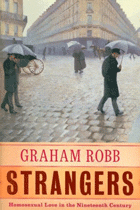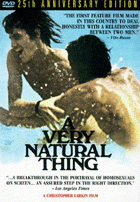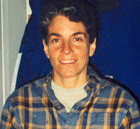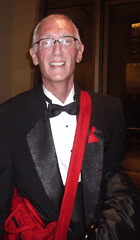 Strangers: Homosexual Love in the Nineteenth Century by Graham Robb 352 pages, $26.95 W.W. Norton & Company; (January 2004) ASIN: 039302038X Based on letters, diaries, and legal records that survive from Europe and America, this non-fiction treatise attempts to depict what life was really like for homosexuals living during the nineteenth century. Whether or not Robb has given an accurate representation is for the reader to judge, but the arguments he makes and supports with evidence are compelling. His basic premise is that contrary to popular opinion, life in the nineteenth century was “not unremittingly bleak. Nineteenth century homosexuals lived under a cloud, but it seldom rained. Most of them suffered, not from the cruel machinery of justice, but from the creeping sense of shame, the fear of losing friends, family, and reputation... incompatibility of religious beliefs and sexual desire, the social and mental isolation...and the strain of concealment.” [30]. Robb states that the persecution heard about that has come to be seen as common to all homosexuals of the time did happen, but more often did not. Written records, and especially legal documents, remain to speak to us of those cases that were prosecuted, but this may be misleading. He likens this to Blacks in the American South at that time; most of them lived with persecution, prejudice, harassment, and hate, some of whom were lynched, but most of whom were not. And yet we hear about lynching more than we hear of those who were not lynched, giving us an erroneous perception that the majority of Blacks living in that time and place suffered this fate. Robb’s claim is that this is also true for the homosexual of nineteenth century; we hear about the high profile cases of discrimination and persecution, and less about the majority who lived, if not openly, with somewhat less turmoil. The book is divided into three parts; the first describes the legal response to homosexuals, the medical community to which homosexuals and their “illness” were subsequently relegated, and to popular opinion at the time. Part Two has a more personal approach, looking at the lives of individuals, where a written record could be retrieved, often in the form of letters and diaries. The records that remain most often were from those of higher social standing, and “unfortunately there is very little good evidence of attitudes among peasants and the working class. Some quiet voices will never be heard.” [119]. Part Three deals with gay culture and literature at the time, clandestine and cloaked in “code” as it often was. Strangers is a very detailed, thoroughly researched work. Robb cites literally hundreds of sources, and at times, his writing can be a little dry, yet overall he has constructed a fascinating, and at times eloquent picture of a time some might have thought lost to us. One is struck with the recognition that in many ways we have come full circle, and in fact gone around more than once, returning and moving beyond popular misconceptions and prejudice, only to repeat that cycle again. Conclusions being drawn, attitudes being accepted and issues being considered as original in the twentieth century were already considered and examined in the nineteenth. For example, Robb writes, “Most of the theories that were used to promote reform now sound apologetic and self-defeating. The idea that homosexuality was natural and innate might have been an argument for decriminalization but it tended to be presented, even as recently as the 1960s in a peculiarly demeaning fashion. Homosexuality was compared by its defenders to color-blindness and congenital deformities...” [183]. At times, the absurdity of the medical and popular beliefs is almost humorous. Robb effectively lets the record speak for itself without any embellishment. In seeking a cure, one line of thought “suggested that an invert [homosexual] placed in an exclusively female environment, might invert himself a second time and become normal, as it were, by a process of ‘double inversion’. [74]. As attitudes began to drift towards a medical ‘cure’ rather than a legal ‘solution’ to homosexuality, science and pseudo-science were employed. “A dash of mathematics [was added] to the moralizing: ‘If several women are brought together in a prison, their erotic shamelessness is cubed.’” [Cesare Lombroso 50]. Robb has given what appears to be an unbiased, fair-minded picture of what life was like for homosexual men and women living in the nineteenth century. His portrait is slanted neither to the bleakly oppressive nor the openly free, but lies somewhere in between the two. For all of the legal, medical, and popular backsliding and repetition, one can see that for the one backwards step, in many ways two forward steps have been taken. No brief review could possibly do this book justice, but can only scratch the surface of Robb’s work. He has presented a fascinating and insightful work. For those whose preferences lie purely with fiction, this book is not recommended. For those interested in an historical look at what the lives of homosexual men and women were like in the nineteenth century, this book cannot be more highly recommended. |
 "A Very Natural Thing"
Director: Christopher Larkin Studio: Water Bearer DVD Release: 1999 Run Time: 85 ASIN:
6305415315
to John...
Make no mistake; although this film was produced in 1974, the issues are pointedly relevant to those of today, thirty years after the film was made. To dismiss this film as outdated would be doing it a great disservice, although the hairstyles and clothing may certainly give those old enough to remember them pause for thought, and possibly a sheepish expression. Director Christopher Larkin uses New York City and the Gay Pride parade as a backdrop (at times) for this story of gay relationships and life. One must keep in mind that thirty years ago, the political, religious and popular atmosphere were different; Gay “pride” was a new concept, AIDS had not yet appeared, and although religious dogma and all that that carries was by no means new, it isn’t given more weight than other issues in this film. David (R. Joel) a seminary student, has just left that path, acknowledging his homosexuality, and headed for New York. He secures a teaching job and meets Mark (C. Gareth) an ad executive. From the outset, one is aware of differences in their approach to homosexuality and relationships, raising a red flag, waiting to see if they will be able to navigate through them, or be overcome by them. David believes that a loving, solid, committed relationship is not only desirable, but possible. Mark comes across as cynical, and self-focused. One can’t help but have a sense of things to come when David playfully squeezes an admission of “I love you,” from Mark during a wrestling match. The exchange is sweet—or would be, but for the fact that one feels the hollow ring to Mark’s words. David pressures Mark into moving in together, to which Mark agrees. As time goes by, the relationship begins to unravel. Eventually Mark takes other lovers; David is unaware. And yet David is not unaware that something is troubling Mark and threatening their relationship. David wants to work through their difficulties; Mark does not. In a misguided willingness to do anything to salvage their relationship, and at Mark’s urging, David agrees to sexual encounters involving multiple partners that he would not ordinarily have wanted. The relationship eventually fails, as it seems destined to do. David seeks the counsel of a friend of his, another gay man. David’s friend tells him that he’s given up on any kind of long-term meaningful relationship, because he doesn’t believe that they exist. David calls his friend cynical; his friend calls himself realistic. And yet David holds to his convictions. He’s been damaged by the failure of his relationship with Mark, and yet has not allowed it to influence his thinking. Working through depression, and forays into the New York City bathhouses of the 70’s he emerges shaken yet whole. When he meets Jason (B. White) at a Gay Pride parade, he seems cautiously ready to consider another relationship. As Jason and David grow closer, we see Jason pressuring David for more of a commitment just as David had once pressured Mark; Jason wants to live with David. When David balks, Jason accuses him of being afraid of commitment. David’s answer reveals how he has blended what he knows with what he’s learned; to force a relationship in a chosen direction before it’s ready, can be done, but to it’s detriment. And yet he can take pleasure in wanting to be with Jason at that moment, and content to see what evolves, knowing that in Jason, he may have found a man who more closely wants the same things he wants. At the heart of this film is David’s true commitment, that is, to the values and beliefs he has, even as he is pressured to give them up; pressure he faces from his friend’s cynical words, and pressure of another kind in the superficiality and impermanence of stereotypical gay life in 1970s New York City, and yet David holds true. The film is tastefully graphic in its sexual scenes; there is nudity and sex, including group sex. It’s realistic, yet minimally revealing. It blends scripted acting with unscripted interviews of people at the 1973 Gay Pride parade, and a gathering afterwards in what appears to be Washington Square Park. The short, documentary-style interviews of gays and lesbians (and in one case the parent of a gay man) contribute a sense of realism. This film, dated in some ways as it is, is as germane and relevant as any made last week or last month. The quest, the questions, and the things for which we all seek are the same as they ever were. And therein lies the beauty of this film. |
 John
Charles, another of the editors at IGW has submitted two reviews for
this issue. One is a nonfiction book called
John
Charles, another of the editors at IGW has submitted two reviews for
this issue. One is a nonfiction book called  The other is a film review of "A Very Natural Thing,"
but one that is special, and I will let John tell you about it:
The other is a film review of "A Very Natural Thing,"
but one that is special, and I will let John tell you about it: